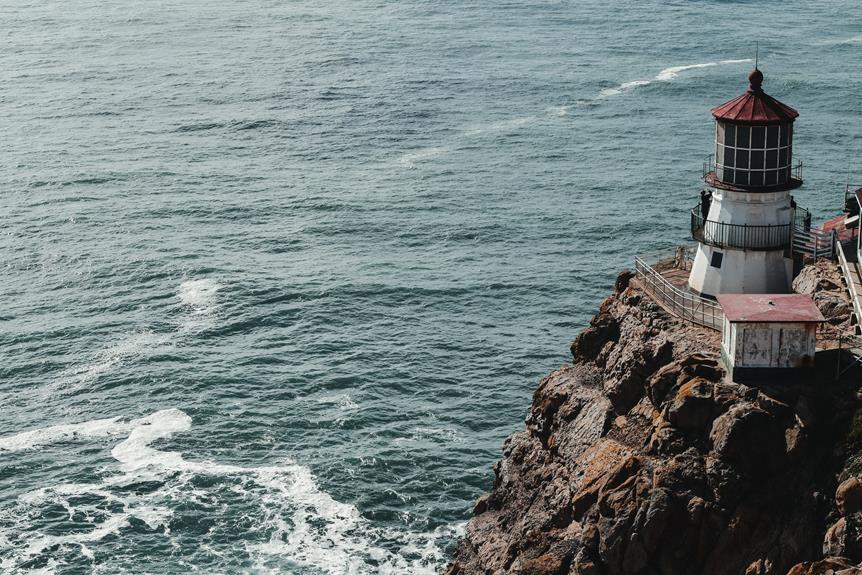Welcome to 'Understanding Algarve's Cliff Formations: A Step-By-Step Guide'! As someone who loves serving others, I am thrilled to share this comprehensive resource with you.
Imagine standing on the golden sands of Praia Dona Ana, gazing up at the majestic cliffs that surround you. This guide will take you on a journey, providing step-by-step instructions on how to explore the breathtaking cliff formations in the Algarve region of Portugal.
From the erosion processes that shape these cliffs to the factors influencing their formation, you'll gain a deep understanding of their geological composition.
With practical tips on transportation and accommodation, as well as an exploration of human impacts, this guide is your key to experiencing the beauty of Algarve's cliff formations.
Key Takeaways
- Algarve's cliff formations were formed through marine erosion, with waves gradually wearing away softer rock layers and leaving behind harder and more resistant cliffs.
- Erosion processes such as mechanical weathering, chemical weathering, and hydraulic action create natural arches, caves, and other unique structures in the cliffs.
- Factors such as wave action, limestone composition, and the region's geological features contribute to the formation of the cliffs and their distinctive rock formations.
- Human activities, particularly uncontrolled tourism and overcrowding, can have negative impacts on the natural environment and the cliffs, including increased erosion and disruption of the natural state of the cliffs.
Formation of Algarve's Cliff Formations
To understand the formation of Algarve's cliff formations, I'll begin by explaining the geological processes that have shaped these stunning natural features.
The stunning rock formations, cliffs, and natural arches found in the Algarve region are the result of millions of years of geological activity. The cliffs, made primarily of limestone and sandstone, were formed through a process known as marine erosion. The constant action of waves crashing against the coastline gradually wore away the softer rock layers, leaving behind the harder and more resistant cliffs. Over time, this process sculpted the unique shapes and features that we see today.
The natural arches, on the other hand, were formed when softer rock layers eroded away, leaving behind a bridge-like structure.
These geological processes, combined with the beauty of the surrounding landscape, contribute to the breathtaking scenery of the Algarve's cliff formations.
Erosion Processes in Algarve's Cliffs
To fully understand the erosion processes in Algarve's cliffs, I'll guide you through a step-by-step exploration of how natural forces shape these remarkable geological formations.
The limestone cliffs in the Algarve region have undergone extensive erosion processes over time, resulting in the formation of unique rock features and breathtaking landscapes. The main erosion processes at play include mechanical weathering, chemical weathering, and hydraulic action.
Mechanical weathering occurs when physical forces, such as wind and waves, break down the rocks into smaller fragments. Chemical weathering involves the dissolution of the limestone by acidic water. Hydraulic action, on the other hand, involves the force of moving water wearing away the rock surface.
These erosion processes have sculpted the cliffs into stunning formations, creating natural arches, caves, and other intricate structures. Understanding these processes is crucial in appreciating the beauty of Algarve's cliffs.
As we delve deeper into the factors influencing cliff formation in the Algarve, we'll explore how the local climate, wave action, and geological composition contribute to the unique characteristics of the region's cliffs.
Factors Influencing Cliff Formation in Algarve
The local climate, wave action, and geological composition play crucial roles in shaping the cliffs of Algarve. Understanding these factors is essential to appreciating the unique formations found along the coastline. Here are five key factors that influence cliff formation in Algarve:
- Ponta da Piedade: This area showcases the power of wave action, as the relentless crashing of waves against the cliffs has sculpted magnificent natural arches and caves.
- Algar Seco cliff: Erosion has created breathtaking blowholes and intricate formations in Carvoeiro, offering a fascinating display of the impact of geological features on cliff formation.
- Benagil Caves: The limestone composition of the cliffs in this area contributes to the formation of the mesmerizing caves, which have been carved out by wave action over time.
- Marine erosion: The constant battering of the cliffs by the ocean waves wears away the limestone, resulting in the formation of dramatic cliff faces.
- Geological features: The presence of limestone cliffs in Algarve provides the ideal conditions for the development of unique rock formations, such as natural arches and caves.
Geological Composition of Algarve's Cliff Formations
As a geologist exploring the cliffs of Algarve, I'm fascinated by the unique geological composition that characterizes this breathtaking coastal region.
The cliffs surrounding Praia Dona Ana and Praia do Camilo are primarily composed of limestone. This sedimentary rock is formed from the accumulation of marine organisms over millions of years. The result is a stunning display of layered formations that showcase the region's geological history.
Another notable cliff formation is found at Praia da Albandeira, where the cliffs are composed of a mix of limestone and sandstone. These rocks have been shaped by the relentless forces of erosion, resulting in intricate caves and arches.
The cliffs of Algarve, with their diverse geological composition, provide a captivating glimpse into the Earth's geological processes and offer a visual feast for all who visit.
Impacts of Human Activities on Algarve's Cliffs
My exploration of Algarve's cliff formations has revealed the significant impacts of human activities on these natural wonders. The following are the impacts of human activities on Algarve's cliffs:
- Uncontrolled tourism and overcrowding at popular beaches like Praia Dona Ana and Praia do Camilo can lead to the degradation of the natural environment and damage to the limestone cliffs.
- Boat tours and recreational activities in the Benagil Caves and surrounding areas may contribute to erosion and harm the rock formations and cliffs.
- The development of Carvoeiro into a tourist destination has resulted in increased human activity, potentially causing environmental impacts on the surrounding cliffs and rock formations.
- Praia da Falésia's accessibility by bus from Albufeira has led to increased foot traffic and human presence, which can disrupt the natural state of the cliffs and sand formations.
- The recommendation to rent a car for exploration can lead to increased traffic and access to remote areas, potentially affecting the natural cliff formations and the surrounding environment.
It is crucial to understand and address these impacts to ensure the preservation and sustainability of Algarve's cliff formations for future generations.
Frequently Asked Questions
Where Are the Rock Formations in Algarve?
The Algarve is home to stunning rock formations that enhance its coastal scenery. These geological features can be found in Lagos, Ponta da Piedade, Carvoeiro, and Albufeira, offering a unique and mesmerizing experience for visitors.
Why Are the Cliffs Red in the Algarve?
The cliffs in the Algarve are red due to the geological composition of sand, clay, and iron minerals. The erosion process over millions of years has caused the iron minerals to rust, resulting in the iconic red cliffs that are a hallmark of the region.
How Many Steps Are There in Ponta Da Piedade?
There are approximately 182 steps at Ponta da Piedade. The best time to visit is early morning to avoid crowds. Nearby attractions include beautiful rock formations, crystal clear waters, and breathtaking views of the Algarve coastline.
How Was Ponta Da Piedade Formed?
Ponta da Piedade was formed through a slow and gradual process driven by geological factors such as wind, rain, and the constant action of the sea. Erosion patterns over thousands of years shaped its unique cliff formations.
Conclusion
In conclusion, after delving into the intricate world of Algarve's cliff formations, it becomes abundantly clear that these geological wonders aren't to be taken lightly.
From the mesmerizing erosion processes to the delicate balance of factors influencing their formation, every aspect of these cliffs demands our attention and admiration.
While human activities may have had their impacts, let's remember to tread lightly and preserve the beauty that nature has so graciously bestowed upon us.



